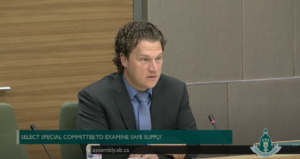
On April 1, the Trudeau Liberals raised the price of everything when they increased the disastrous carbon tax by another 23 per cent — a crushing blow for families and businesses.
Although this may seem like an April Fool’s Day prank, it is anything but for people already struggling to cope with an affordability crisis that has made it impossible to make ends meet.
As someone who spent years working in Alberta and Canada’s charitable sector, I’m especially concerned about the effect this latest carbon tax hike will have on the charities that do so much important work in our communities, often on shoestring budgets. Despite the important work charities do, these critical organizations get little forgiveness in paying the carbon tax. I consider this a national disgrace.
The repercussions of the carbon tax hike will only make life harder and more expensive for Alberta’s charities.
Our food banks are already witnessing unprecedented demand. Food bank use in Canada is up 78.5 per cent since 2019, and one in five Canadians report skipping meals due to increased food costs. Our food banks already struggle with sourcing nutritious food at affordable prices. This carbon tax hike will directly translate to increased transportation costs for food suppliers, which will inevitably trickle down to the food banks. As a result, food banks will be forced to stretch limited budgets even further, potentially reducing the quantity or quality of the food they provide at a time of record need.
Read the rest of my recent column in the Calgary Herald here.
To restore housing affordability, we need to make it easier to build more homes. And we’re doing that in Alberta. Housing starts in Calgary are up 35% from last year, and housing completions have risen by 54%.
Across Canada it’s a different picture, the Canada Mortgage and Housing Corporation (CMHC) predicts lower numbers of housing starts in 2024. In fact they paint a bleak picture for 2024, with increased rents, higher demand (due to immigration), and record-low vacancy rates.
Record levels of immigration are driving up rent, and the price of home ownership. In January the CBC reported that the Federal government was warned 2 years ago that increased immigration levels would make housing more expensive. The report also advised that housing construction was not keeping pace with population growth. Despite this, Justin Trudeau’s Liberals pushed ahead with increasing the number of immigrants brought into Canada.
The latest announcement from the Liberal Party is the “Rental Protection Fund”. This policy will not result in any new homes being built. Instead, it purports to offer money to non-profits to purchase market apartment buildings should they be listed for sale. This policy will not put more shovels in the ground and will tie non-profits to strict Federal eligibility criteria. It also oversteps into Municipal and Provincial jurisdictions, again.
Here in Alberta, we do our best to make it easier to build a home. But we need a Federal government that will work with, not around the Provinces. We also need a government that understands if you invite people to come live in Canada, they are going to need somewhere to live.
Canada spends just under 1.4% of its GDP on defense, by contrast it’s now spending 27% of its GDP on the public sector. Even Liberal Defense Minister Bill Blair, doesn’t seem to have much positive to say about Canada’s defense force.
“Canada must and will spend more on defense,” Bill Blair told the annual Ottawa Conference on Security and Defense. “We know we need to do much more.” Reuters reported last month.
He’s also suggested the Canadian Forces are facing “a death spiral” when it comes to recruitment, according to a Global News story. More people are leaving the Canadian Armed Forces rather than joining it.
A Conservative government will properly fund Canada’s defense forces. We’ll increase recruitment for our Armed Forces, and replace outdated and worn-out equipment. Canada has large open borders, particularly in the Arctic that need a proper defense force. We’ll meet our NATO commitments, and help keep Canada the true north strong and free.
46.8 billion dollars. That’s the projected deficit in the upcoming Federal Budget. 46.8 billion dollars is also bigger than the total GDPs of many sovereign nations. And the deficit may not stop there. Parliamentary Budget Officer Yves Giroux has admitted that the upcoming Federal Budget doesn’t account for costly initiatives like the NDP pharmacare plan. The deficit may end up being far higher, and taxpayers may be on the hook for much longer.
2016 was the first full year of Justin Trudeau’s Liberal government in Canada, and since 2016 jobs in the Federal public sector have grown by over 68%! That growth rate is much higher than our population growth rate over the same time period. And that number doesn’t include the ever-growing number of consultants hired by the Liberal government. Over 67.4 billion dollars were spent on Federal public sector salaries in 2023. That is the most that has ever been spent on public sector salaries in Canadian history!
CD Howe has called business investment in Canada lackluster since 2015, and write that current Federal tax reforms favour redistribution. Is it any wonder that our national productivity fell for seven straight quarters? The cost of doing business in Canada continues to grow, and the size of government continues to grow off the backs of hard-working taxpayers. We unfortunately have a government that is led more by ideology than sound monetary policy. Until we elect a common sense Conservative government, the federal deficit will continue to grow and taxpayers will be left holding the bill.
One of the most consistent and growing themes at the doors and in political conversations has been a lament for the loss of healthy political debate. There is a growing sense of dread at the thought of political discussion, I think this is because there is a growing sense of dogma attached to it. If you are not with us, you are against us, you are evil, immoral, or bad in some way. When political debate has devolved into this sentiment then I tend to understand why more people are just avoiding the topic altogether.
In Jonathan Haidt’s 2018 book The Coddling of the American Mind he writes about one of the great untruths of our age; life is a battle between good and evil people. Our current government has unfortunately played on this division, they have used fear and anger to drive votes.
We need leadership that will work to unify not demonize. Leadership that will build bridges that start from the premise that we all desire good, we just have different ideas on how to achieve that good.
“The line dividing good and evil cuts through the heart of every human being.” Alexsandr Solzhenitsyn

The same little squares of foil that litter downtown Portland, litter downtown Calgary as well. You’ve probably stepped over a few. These little pieces of foil are used to smoke fentanyl. Earlier this year, Portland declared a 90 day state of emergency because of the rampant fentanyl use in the city. The state of emergency culminated in Portland City Council voting to recriminalize hard drug possession. Portland had decriminalized drug possession only a few years earlier, and was being held up as model city.
Unfortunately our neighbours in British Columbia have decided to follow Portland circa 2020, and decriminalize hard drug possession. British Columbia also practices “safe supply” which I wrote about in my last newsletter. Since last writing, police in Prince George have seized over 10,000 pills, many of which had come from “safe supply” programs. I share our Premier’s concern that these drugs could have been diverted across Canada.
Reading reports in the National Post like this “Clinicians throughout the province reported that they felt ill-equipped to handle the risks of high-dose opioid prescribing and that they were being pressured by the government into providing safer supply, despite feeling uncomfortable with the program.” Should sound alarm bells that the program isn’t working.
Good ideas are worth repeating, and so I will end this article the same way I ended the last one. The Alberta Model for opioid recovery is world-class. Let’s make the Alberta Model the Canada Model and show that recovery is possible.
Jeremy is an accomplished nonprofit leader, with political acumen. Before his foray into politics, Jeremy worked for over fifteen years in the non-profit sector with some of the most vulnerable members of society.